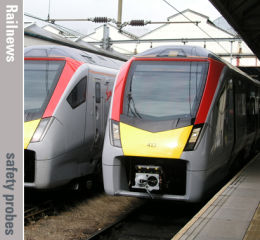Posted 12th December 2019 | 1 Comment
Mystery signalling faults are disrupting Greater Anglia services

DISRUPTION of Greater Anglia services being worked by the new Stadler trains appears to be caused by signalling problems, but an investigation by Greater Anglia and Network Rail has so far failed to find the cause.
Services on several rural and regional lines in East Anglia have been disrupted over the past couple of weeks.
Meanwhile, the Rail Accident Investigation Branch has launched an inquiry into an incident at Norwich Road automatic half barrier level crossing on the line to Cromer on 24 November, which also involved a new Class 755 Stadler unit. The train, the 19.45 Norwich to Sheringham service, was approaching the crossing at about 45mph (72km/h) when the warning lights went out and the barriers lifted.
Road traffic started to cross, although the train was no more than 200m from the crossing. The driver made an emergency brake application and sounded the horn, but a collision with a car was only avoided by a margin of about a quarter of a second, according to the RAIB. The crossing was last equipped in 2000, and it includes a ‘predictor’ system which detects the speed of approaching trains. Engineers are focusing on this system, and whether the new Stadler train was a factor.
Another incident affecting one of the new trains occurred on 2 December, when a pantograph failed to lower as the train left the electrified Great Eastern main line at Haughley Junction and then struck a bridge between there and Elmswell station. The train was delayed for two hours at Elmswell while Network Rail checked the line and fitters from Stadler removed the damaged pantograph.
Greater Anglia said: ‘The issue with the pantograph has been rectified. We are confident this was an isolated incident and not associated with the design of the train. It is not connected in any way with the current signalling problems.’
The operator added: ‘We're really sorry, but we can't say at the moment when normal service will be resumed. But we are working closely with Network Rail to get the service back to normal as quickly as possible.’
Reader Comments:
Views expressed in submitted comments are that of the author, and not necessarily shared by Railnews.

Jez Milton, Manchester
This is a Network Rail failure, surely. Why on earth is any signalling system requiring 'prediction'? Try detection.
Time for a hard look at Network Rail, and its obscenely paid public sector 'executives'.